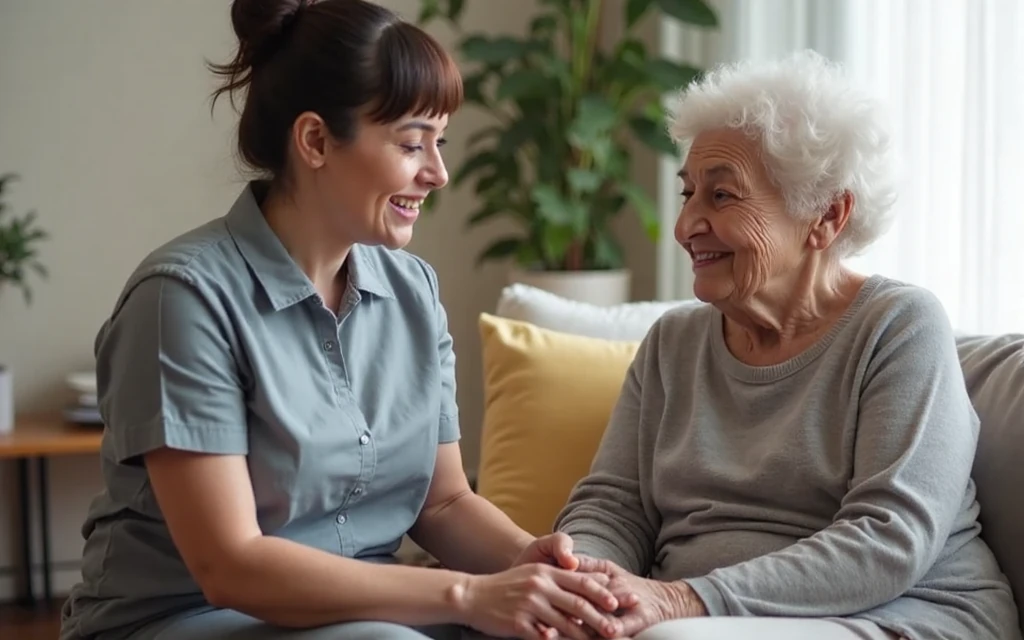The Power of Meaningful Conversations in Caregiving
For caregivers, conversation is more than just passing time—it’s a bridge to connection, understanding, and emotional well-being. Meaningful discussions help clients feel valued, engaged, and mentally stimulated, while also allowing caregivers to build trust and rapport. Whether supporting an elderly individual, someone with cognitive impairments, or a person recovering from illness, knowing how to spark and sustain conversations can transform daily interactions into enriching experiences.
Yet, many caregivers struggle with knowing what to say. What if a topic upsets the client? What if the conversation feels forced or awkward? Finding the right balance between engaging and appropriate topics requires patience, observation, and adaptability. In this guide, we’ll explore practical strategies to help caregivers develop engaging discussions that foster warmth, companionship, and mutual enjoyment.
Understanding the Client’s Interests and Communication Style
Every person has a unique way of engaging in conversation. Some are naturally talkative, while others prefer quiet companionship. To create meaningful discussions, caregivers must first understand their client’s communication style.
- Assessing personality: Is the client an introvert who prefers deep, reflective conversations, or an extrovert who enjoys lighthearted banter?
- Observing non-verbal cues: Does the client’s face light up when discussing certain topics? Do they withdraw or appear disinterested in others?
- Asking open-ended questions: Instead of “Do you like music?” ask, “What kind of music did you enjoy growing up?”
- Recognizing cultural and generational preferences: Topics that resonate with a 90-year-old may be different from those that engage a younger client.
A caregiver’s role is to listen closely, learn from the client’s responses, and gently guide conversations toward subjects that spark joy and interest.
Finding Relevant Conversation Topics
Once a caregiver understands their client’s interests, the next step is to find conversation starters that feel natural and engaging.
1. The Client’s Personal History and Experiences
Everyone has a story to tell, and reminiscing can be a deeply fulfilling experience—especially for older adults. Asking about a client’s past can lead to meaningful discussions and provide a sense of validation.
- “Tell me about your first job—what was it like?”
- “What’s a family tradition that you’ve always cherished?”
- “Did you ever take a memorable trip? What was the best part?”
These questions invite storytelling and can help clients feel heard and appreciated. If a client struggles with memory recall, simple prompts like, “I heard people used to go to dance halls on weekends—was that something you ever did?” can gently jog memories.
2. Everyday Life and Shared Experiences
Sometimes, the best conversations come from life’s simple moments.
- Meals and routines: “What’s a dish you loved growing up?”
- Weather and seasons: “Do you have a favorite season? Why?”
- Community events: “Did you ever go to fairs or local gatherings?”
When clients feel involved in the world around them, they are more likely to engage. A simple chat about the morning’s breakfast or an upcoming community event can spark meaningful dialogue.
3. Hobbies, Interests, and Passions
People light up when discussing their passions. Whether it’s books, music, or gardening, tapping into hobbies can lead to engaging, joyful conversations.
- “I’m thinking of starting a garden—do you have any advice?”
- “I heard a song today that reminded me of old jazz tunes. Do you have a favorite musician?”
- “You always seem to enjoy puzzles—what do you like most about them?”
By showing genuine curiosity, caregivers encourage clients to share their knowledge and enthusiasm.
4. Lighthearted and Engaging Topics
Not all conversations need to be deep. Sometimes, a bit of humor or lighthearted discussion is just what’s needed.
- Jokes and fun facts: “Did you know octopuses have three hearts?”
- Pets and nature: “Have you ever had a pet? What was its name?”
- Holidays and celebrations: “Do you have a favorite holiday tradition?”
These topics help keep conversations lively and positive.
5. Current Events and News (With Sensitivity)
Discussing current events can keep clients engaged with the world, but it’s important to approach these topics with care.
- Focus on uplifting news: “I read about a 100-year-old woman who ran a marathon—how amazing is that?”
- Local happenings: “The town is hosting a farmer’s market this weekend—do you enjoy fresh produce?”
- Avoid distressing topics: If a news story is controversial or upsetting, it’s best to steer clear.
By choosing positive or neutral news, caregivers can encourage engagement without causing unnecessary stress.
Adapting Conversations to Cognitive and Emotional Needs
Not all clients communicate the same way, and some may face cognitive challenges that make conversation difficult. Tailoring discussions to their needs can enhance engagement and emotional well-being.
- For clients with dementia: Reminiscence therapy—using old photos, music, or familiar scents—can help spark memories.
- For clients with speech difficulties: Visual aids like pictures, gestures, or written words can support communication.
- For emotionally sensitive clients: Being aware of their mood and avoiding distressing topics can ensure conversations remain positive.
Patience is key. If a client struggles to respond, giving them time and repeating key points can help keep the conversation flowing.
Keeping Conversations Natural and Engaging
Good conversation isn’t just about what is said—it’s about how it’s said.
- Practice active listening: Maintain eye contact, nod, and show engagement with phrases like, “That’s interesting!”
- Use prompts and storytelling: “I once got caught in the rain without an umbrella—have you ever had something like that happen?”
- Let the client lead: If they seem eager to discuss a topic, encourage them to share more.
- Be mindful of their comfort: If a topic seems to make them uneasy, gently shift the discussion.
The best conversations feel effortless and natural, flowing based on interest and mood.
Overcoming Communication Barriers
Some clients may have difficulty hearing, speaking, or remembering details. Being aware of these challenges can help caregivers navigate conversations more effectively.
- For hearing impairments: Speak clearly, face the client, and minimize background noise.
- For memory lapses: Instead of correcting mistakes, go along with the conversation to keep it positive.
- For speech difficulties: Use simple phrases, visual aids, or even touch (like holding a hand) to communicate warmth.
- For moments of silence: Sometimes, quiet companionship is just as valuable as words.
Conclusion: The Lasting Impact of Meaningful Conversations
A good conversation can brighten a client’s day, spark cherished memories, and provide a sense of connection. Caregivers who take the time to learn about their clients, adapt to their needs, and engage with warmth and curiosity can create an environment of comfort and joy.
By continuously exploring new topics, embracing patience, and fostering genuine engagement, caregivers can turn simple conversations into moments of deep companionship and care.





